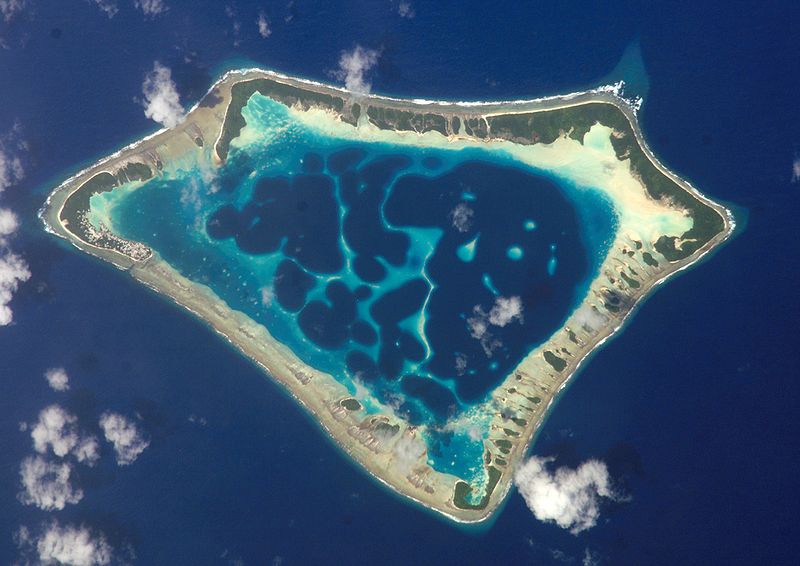Science News
Atoll Tale

Three interesting points of research have come out recently about atolls in the South Pacific. Because many atolls are remote, they can teach us a lot about healthy coral reef ecosystems and their future.
In case you were wondering what an atoll is, according to the Encyclopedia of Earth:
Atolls are circular, oval, or horseshoe-shaped arrays of coral reef islands that are perched around an oceanic volcanic seamount and encircle a shallow central lagoon…. Because atoll formation requires coral reef building, atolls are limited to tropical waters.
(View this great animation here of an atoll forming over 30 million years.)
Healthy Fishing
To gain new insights on the ecology of reef fishing, Stanford researchers are comparing and contrasting the reefs of two atolls—Palmyra and Tabuaeran.
Palmyra is a protected U.S. wildlife refuge and prohibits fishing along its shores. Tabuaeran is part of the Republic of Kiribati and is home to about 2,500 people who depend on the reef for food and income.
Signs of a healthy marine ecosystem usually include the presence of large fish and sharks. “Palmyra has some of the highest densities of sharks and other large fish of any coral reef in the world,” said Douglas McCauley, a graduate student at Stanford. “That's clear within seconds of jumping in the water there.”
But in Tabuaeran, where fishing is a way of life, sharks and other large species are in short supply, McCauley said. “That was surprising, because Tabuaeran is a somewhat lightly populated island. Most people arrived only a few decades ago, and fishing there is still very artisanal in nature.”
Big fish grow and reproduce slowly, so their populations take longer to recover, he added. “It appears that it takes very little harvesting to reduce populations of these sensitive, large reef fish.”
The Stanford researchers are hoping to pass this information along to the people of Tabuaeran so they can fish more sustainably. Over the past three years, the team taught science classes at local schools on topics such as reef ecology and genetics and conducted town hall meetings at every village on the atoll.
Because the livelihoods of so many Tabuaerans depend on healthy fisheries, locals are eager to preserve fish numbers, McCauley said. "Those who depend most on the environment can and should be its best stewards," he added.
Millennium Atoll: A Pristine Ecosystem
Millennium Atoll, also part of the Republic of Kiribati, is one of the most remote, pristine atolls in the world. Its lagoon is highly enclosed, sealing it away from the outside world. Californian and Hawaiian scientists studied its life and published their findings last week in PLoS One:
This is the first comprehensive survey of the lagoon at Millennium Atoll, which contains some of the few remaining coral reefs that are relatively unaltered by human activity. The lagoon of the atoll is home to a variety of unique organisms that are threatened in many areas of the world.
Valuable resource species such as clams, sharks, Napoleon wrasse, sea turtles, and lobster are fairly abundant at Millennium but have been seriously overexploited elsewhere around the world.
Protection of Millennium's coral reefs should be a priority for the Republic of Kiritbati as these habitats are not only unique but are some of the world's least impacted reef systems.
Atolls Growing, Not Shrinking
Finally, last month Australian researchers published the incredible finding that despite warnings of small atolls and islands disappearing with sea level rise, they have found that in the Pacific, some have actually grown in the last 60 years.
Despite evidence of the sea level rising as high as five inches in the region, of the 27 islands they studied, four decreased in size, but the rest remained the same or grew.
It may simply be due to the nature of atoll formation itself. From New Scientist:
Because the corals are alive, they provide a continuous supply of material. “Atolls are composed of once-living material,” says Arthur Webb, “so you have a continual growth.”
The researchers stress these results reflect a small portion of atolls in one area in the Pacific and that “warnings about rising sea levels must still be taken seriously.”
With so much research emerging about atolls, it’s obvious we still have a lot to learn. These little islands are making big waves in the scientific community.